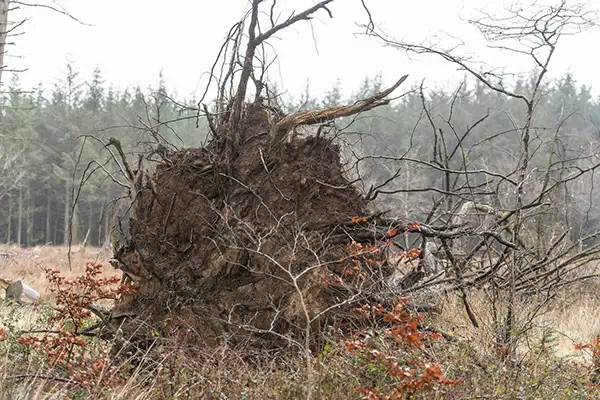When storms loom on the horizon, the safety of your property heavily depends on the integrity of the trees surrounding it.
Regular assessments by tree services are crucial, as they can uncover hidden risks before severe weather strikes.
These experts identify weak branches and address potential diseases, significantly enhancing your property’s resilience.
However, it’s equally important to consider what happens after the storm.
A comprehensive understanding of tree services can better equip you to prepare your landscape for future challenges, ensuring ongoing safety and vitality.
Assessing Tree Health and Stability Before Storms
Preparing your trees for storms is crucial to protect your property and ensure their long-term health.
Pre-Storm Tree Inspection:
- Visual Inspection: Conduct a thorough visual inspection of your trees before a storm. Look for any signs of weakness or damage, such as:
- Cracked or Split Branches:
- Dead or Dying Branches:
- Cavities or Hollows in the Trunk:
- Leaning Trees:
- Signs of Disease or Pest Infestation:
- Root System Assessment: Observe the surrounding soil for any signs of root exposure, soil erosion, or compacted soil.
Identifying High-Risk Trees:
- Trees Near Structures: Pay close attention to trees located near your home, outbuildings, power lines, or other structures.
- Large, Mature Trees: Large, mature trees are more susceptible to storm damage due to their size and weight.
- Trees with Weak Structures: Trees with weak or damaged branches, leaning trunks, or shallow root systems are at higher risk of falling.
Professional Consultation:
- Certified Arborist Assessment: Consider consulting with a certified arborist for a professional assessment of your trees.
- Expert Evaluation: Arborists can identify potential hazards and recommend appropriate mitigation measures, such as pruning, cabling, or bracing.
Taking Action:
- Address Identified Issues: Address any identified issues promptly, such as pruning weak or damaged branches, removing deadwood, or providing support to unstable trees.
- Storm Preparedness: Secure loose branches and objects around your property that could become projectiles during a storm.
By taking these proactive steps to assess tree health and stability before a storm, you can minimize the risk of property damage and ensure the safety of your family and your trees.
Emergency Clean-Up and Recovery After Severe Weather
Severe weather events, such as strong winds, heavy rains, or ice storms, can cause significant damage to trees and property. Prompt and effective cleanup is crucial for ensuring safety and minimizing further damage.
Assess the Damage:
- Safety First: Prioritize safety. Do not enter areas where downed power lines or other hazards are present.
- Assess Tree Damage: Carefully inspect all trees on your property for damage, including broken branches, uprooted trees, and leaning trees.
- Identify Hazards: Identify and remove any immediate hazards, such as fallen branches blocking walkways or driveways.
Professional Tree Removal Services:
- Contact a Qualified Arborist: Contact a qualified and insured tree service for assistance with the removal of downed trees and large branches.
- Expert Assessment: Professional arborists can assess the extent of the damage and recommend the safest and most effective removal techniques.
- Equipment and Expertise: Tree service companies have the specialized equipment and expertise to safely and efficiently remove downed trees and debris.
Debris Removal and Cleanup:
- Clear Debris: Remove fallen branches, leaves, and other debris from your property.
- Dispose of Debris Properly: Dispose of debris responsibly, following local guidelines for yard waste disposal.
Property Inspection:
- Inspect for Structural Damage: Inspect your home and other structures for any damage caused by falling trees or debris.
- Address Roof and Gutter Damage: Check for damage to your roof, gutters, and downspouts.
Preventative Measures:
- Tree Health Assessment: After the storm, have a certified arborist assess the health of your remaining trees and recommend any necessary pruning or other maintenance to prevent future storm damage.
By taking prompt action and seeking professional assistance when necessary, you can effectively address storm damage, ensure the safety of your property, and expedite the recovery process.
Preventative Measures for Future Storm Resilience
Taking proactive steps to enhance the storm resilience of your landscape can significantly reduce damage and minimize the impact of severe weather events.
Tree Health and Stability:
- Regular Tree Inspections: Conduct regular inspections of trees for signs of weakness, such as dead or dying branches, cavities, or leaning.
- Professional Tree Care: Engage a certified arborist for professional assessments and recommendations for pruning, cabling, or other necessary treatments.
- Tree Selection: When planting new trees, choose species that are known for their storm resilience and adaptability to local conditions.
Root System Health:
- Improve Soil Drainage: Ensure proper drainage around trees to prevent root rot and improve their stability.
- Avoid Compacting Soil: Avoid compacting the soil around tree roots, which can restrict root growth and weaken the tree.
- Mulch Application: Apply a layer of organic mulch around the base of trees to help retain moisture, regulate soil temperature, and suppress weeds.
Structural Considerations:
- Secure Loose Objects: Secure loose objects around your property, such as outdoor furniture, grills, and children’s toys, to prevent them from becoming projectiles during a storm.
- Trim Overhanging Branches: Trim branches that overhang your roof or come into contact with power lines.
- Reinforce Structures: Consider reinforcing structures, such as fences and pergolas, to withstand strong winds.
Drainage and Water Management:
- Improve Drainage: Install gutters and downspouts to direct rainwater away from your foundation.
- Create Drainage Swales: Consider creating swales or other drainage features to direct water away from your property.
- Minimize Runoff: Minimize impervious surfaces, such as concrete and asphalt, to allow rainwater to infiltrate the soil.
By implementing these preventative measures, you can significantly enhance the storm resilience of your landscape, protect your property, and minimize the impact of future weather events.
Proactive tree care is vital for both pre- and post-storm safety. Regular assessments by qualified arborists, prompt emergency cleanup, and the implementation of preventative measures can significantly enhance the resilience of your trees and landscape.
By understanding the role of tree services in each phase – from pre-storm inspections and mitigation to post-storm recovery and long-term resilience – you can better protect your property, minimize damage, and ensure the ongoing health and vitality of your trees, even in the face of severe weather.

